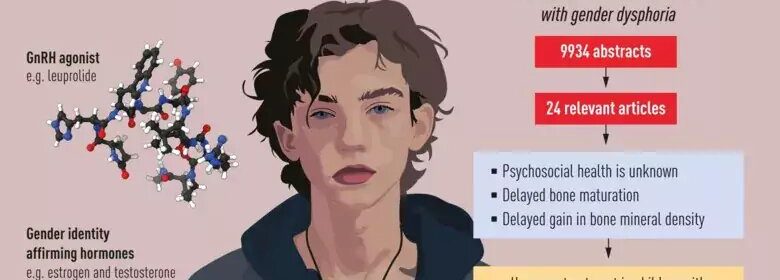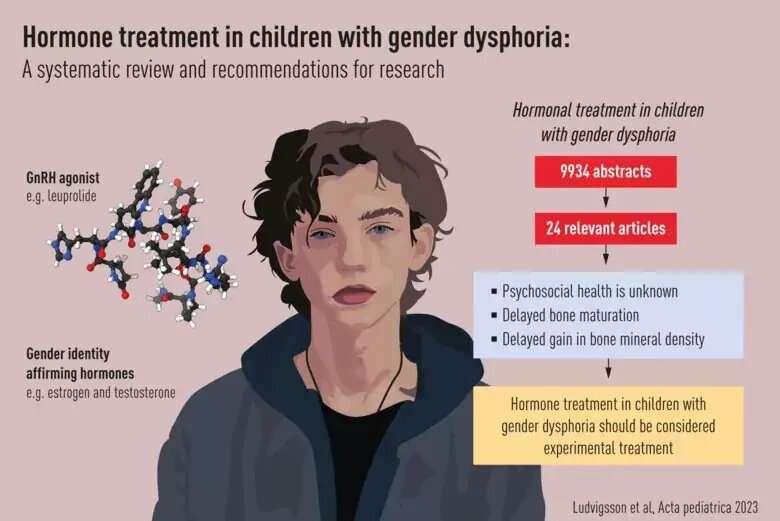Systematic review on outcomes of hormonal treatment in youths with gender dysphoria

In a systematic review published in Acta Paediatrica, researchers from Karolinska Institutet, University of Gothenburg, Umeå University, and the Swedish agency for health technology assessment and assessment of social services mapped the current knowledge of hormonal treatment in youths under 18 years old with gender dysphoria.
Data on the effects on psychosocial health are lacking but there is some evidence that hormonal treatment may impact bone maturation. The researchers conclude that hormonal treatment of gender dysphoria in this age group should be regarded as experimental treatment rather than standard procedure.
Gender incongruence refers to a mismatch between biological sex and perceived gender identity. When gender incongruence causes significant discomfort, it is called gender dysphoria. Recent data suggest a dramatic increase of gender dysphoria in young people in the Western world. There has also been an increase in the number of young people requesting hormonal treatment but so far, little is known about the long-term consequences of such treatment.
In a systematic review, researchers assessed more than 9,900 abstracts from 15 scientific databases and identified 24 relevant studies.
“In our review, we focused on psychosocial effects, bone health, body composition and metabolism, and therapy persistence in children (<18 years of age) with gender dysphoria undergoing treatment with so-called puberty blockers, gonadotropin-releasing hormone analogues (GnRHa)," says lead author Professor Jonas F Ludvigsson, pediatrician at Örebro University Hospital, and Professor at the Department of Medical Epidemiology and Biostatistics, Karolinska Institutet. "I am surprised by the shortage of studies in this field. We found no randomized trials, and only 24 relevant observational studies," he adds.
The review concluded that the long-term effects of hormone therapy on psychosocial health could not be evaluated due to lack of studies with sufficient quality. Concerning bone health, GnRHa treatment delays bone maturation and bone mineral density gain that, however, seem to partially recover during cross-sex hormone therapy when studied at age 22.
“Our work is important not only because the incidence of young people with gender dysphoria has increased during a short period of time, but also because of the change in case-mix. We do not know what the natural trajectory is for these children. Studies should first elucidate to what extent gender dysphoria spontaneously remit in adolescents who have not presented gender incongruent behavior in childhood. If predictors for persistence can be found, the second step would be to conduct clinical trials focusing on potential persisters in order to evaluate the beneficial and adverse effects of hormonal treatments. Importantly, such studies need to follow patients for many years,” says corresponding author Professor Mikael Landén, at Karolinska Institutet and University of Gothenburg.
“Against the background of almost non-existent longterm data, we conclude that GnRHa treatment in children with gender dysphoria should be considered experimental treatment rather than standard procedure. This is to say that treatment should only be administered in the context of a clinical trial under informed consent,” he adds.
“We found substantial limitations in earlier research on gender dysphoria, and the few longitudinal observational studies were hampered by small numbers, and high attrition rates,” adds Ludvigsson. “For that reason we created a checklist, the GENDHOR checklist, that we hope will facilitate and increase the quality of future research in this field.”
More information:
Jonas F. Ludvigsson et al, A systematic review of hormone treatment for children with gender dysphoria and recommendations for research, Acta Paediatrica (2023). DOI: 10.1111/apa.16791
Journal information:
Acta Paediatrica
Source: Read Full Article
